|
Our
feature opens somewhere near the mountain
ranges
of central Illinois (--
well,
at least we never see any palm trees...),
where the camera slowly pans, following the noise of a
boisterous ballad bellowing out of a car
radio, until it settles on a couple of
teenagers parked in a secluded lover's lane -- who
are also breaking a Cardinal B-movie Sin by
engaging in some passionate, premarital
necking. Lost in the heat of teenage
hormones, the couple continues their mutual
groping until they're distracted by a
noise outside the car; and after they
pause to look out, then up, they both scream at some horrible
menace that's abruptly cut off by the
opening credits.
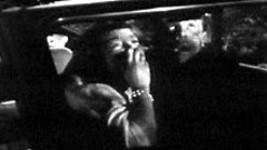
When
the wrecked car is found covered in blood,
the authorities find no other trace of the
bodies -- he typed ominously.
Trying to find the owner, the car's registration leads the State Police
to nearby Ludlow, where they make an even
more startling discovery: the entire
town has been leveled to the ground! But
once again, after searching through the
wreckage, there are no bodies to be found anywhere.
This proves a little too weird for the
local authorities, so the National Guard
is brought in to investigate what appears
to be some kind of natural disaster. Setting up
camp in the neighboring town of Paxton,
they cordon off what's left of Ludlow
until some answers can be found as to what
happened to its 150 residents ... Enter
intrepid reporter, Audrey Aimes (Peggy
Castle), stage left -- erk,
make that highway
left. On her way to cover a different story,
she becomes intrigued when she canít get
any straight answers as to whatís beyond
the military roadblock. Heading on into
Paxton, the reporter is stonewalled
further by Col. Sturgeon (Thomas Henry
Browne -- who is not Morris Ankrum),
who will confirm nor deny anything.
Playing
a hunch, Aimes calls her editor to see
if there are any atomic installations in
the area. (Remember,
this is the 1950's and radiation took the
blame for damn near everything.) But
the only thing even remotely close to what
she's suggesting is a Department of
Agriculture research lab. It's probably a dead-end,
but Aimes
investigates her only lead, and, while
visiting the lab, she
meets our square-jawed hero, Dr. Ed
Wainwright (Peter Graves),
and his partner, Dr. Frank Johnson (Than
Wyenn), who has been rendered deaf
and mute by an accidental dose of
radiation. Obviously, judging by the embarrassing
floor show that follows, these two don't
get many visitors, but they do go on to
explain that their experiments involve the
use of radiation to speed up the
photosynthesis process, resulting in giant
mutations. (Tomatoes the size of
basketballs etc.) Though
impressed
with their massive end-results, Aimes is
curiously concerned about any possible
side-effects. But Wainwright assures that they've had no problems -- except for
some bugs, especially the locusts, who
kept eating their experiments. Oh, and
then there was that little problem with
the storage bins for the mutant grain:
seems they inexplicably collapsed, and all their
irradiated contents disappeared under
mysterious circumstances (--
but I'm sure it's nothing).
Returning
to Paxton, after promising to hold her
story until the mystery is solved, Aimes
is finally allowed to go into Ludlow and
is shocked by what she sees: the town is
beyond devastated; it's been completely
torn asunder and flattened. Putting two
and two together (--
sheís a crack reporter, remember),
Aimes decides to visit the destroyed grain
bins for a little compare and contrast.
(Dang sheís good.)
Going back to the institute for
directions, the doctors decide to tag
along. Turns out the storage bins are
in even worse shape than Ludlow, and while
Wainwright and Aimes get to know one
another, poor Dr. Frank discovers whatís
been causing all the trouble -- and then
promptly gets eaten by it at the same
time! For it seems that after eating all
the irradiated grain, Dr. Wainwright's
harmless locusts aren't quite so harmless after
all...
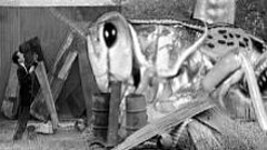
Friends,
video-philes, and my loyal B-movie
Brethren, lend me your ears. For
I have come not to bury Bert I. Gordon,
but to praise him ... Weeellll
praise might be too strong of a word.
Yeah, yeah, I know, this whole movie is
just one big, cheapjack knock-off of THEM!,
right? Well, yeah -- ya got me there. However, I think it is
high time we take a step back, inhale
deeply, and stop skewering his films
because of the cut and paste matte-shots
of real bugs crawling over picture postcards of
famous locales to make them look ginormous.
Let us try to forgive the use of iguanas and
gators for dinosaurs, locked in bloody gladiatorial
combat for cinematic eternity, and cut the guy a
little slack.
There.
Now don't you feel better?
His
films, while not epics, are nowhere near
as bad as their dubious reputations. I
mean, really, you bought/rented a movie
about giant mutant grasshoppers invading
Chicago -- What did you expect? And I
can think of plenty of other films in the
genre that are much worse than this, like
... uhm, like, uh -- gimme
a second!
Like King
Dinosaur.
...
What?
That
was him?
Uhm
Ö god
#*@% it, I LIKED TORMENTED!
*sigh*
Oh,
well...
Beginning
of the End was Gordon's third feature
and the last to bear the old Republic
Pictures logo. Before directing his
first film, Serpent
Island, Gordon
learned the tools of the trade producing
commercials, and later working as an
editor and production assistant on several
TV shows.
And after hammering out a few
rear-projection kinks in the aforementioned
King
Dinosaur, he
and his wife, Nora, who often served as
his technical assistant, turned out a much
more solid-effort in this actioneer.
Granted, it's shoddy at first glance,
but if you look a little closer and a
little harder, you can see the time and
effort it took to match and layer all
that footage together. And as impressive
as the giant ant mock-ups were in the THEM!,
there is some kind of strange fusion when you watch the lightning quick,
super-imposed locusts swarming all over
the screen -- especially during the
combat scenes. But, we're getting ahead
of ourselves, so -- back to the review
already in progress...
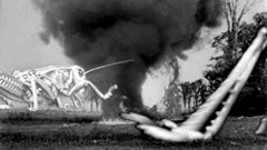
Barely
escaping the deadly swarm, and after
relating their fantastic tale to Sturgeon,
Wainwright's claims of giant killer bugs
are met with much skepticism.
Luckily, through persistence, the
survivors manage to at least convince the
Colonel to
investigate the wrecked storage site.
Ordering Captain Barton (James Seay -- who
is still not Morris Ankrum) and
a squad of infantry to go with Wainwright
back to the scene of the alleged attack,
upon
reaching the site, all seems quiet -- too
quiet, but not for long! For suddenly, from
out of nowhere, the locust start
screeching at deafening levels and then
attack! Then and thus, the crack-squad that thought it was on a
snipe-hunt now finds themselves in a nasty firefight.
Hopelessly outnumbered and on the verge of
being overwhelmed and wiped-out, they beat
a hasty retreat back to Paxton for some
reinforcements. And
while Sturgeon quickly mobilizes his
entire unit for the Battle of Paxton,
Wainwright tries to warn him that there
are too many giant locusts and they
wonít stand a chance unless the regular
army is called in. (He
can tell by the levels of chirping that
the swarm has to be pretty big.)
To
accomplish that we get an obligatory trip
to Washington DC, where Wainwright
pleads his case in front of a committee
run by General Hanson (Morris
Ankrum -- FINALLY!
Heíll fix this.) But
once again, the big brass doesnít
understand the magnitude of the threat
until they receive word that Paxton has
been overrun and destroyed by the locust
swarm. With that, Hanson takes command (--
thank god), and appoints Wainwright
as his special advisor on giant mutant
bugs and how to properly squash them.
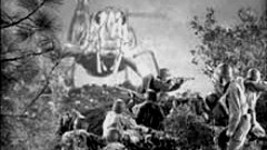
But
even
though the army is mobilized and engages
the enemy with everything they've got --
tanks, artillery, and napalm -- they have
little effect in slowing the swarm down as
it closes in on Chicago. Insecticides and
smoke donít have any effect, either; and
after a rousing battle sequence between
the GIís and the giant bugs, the locusts
breach the lines and are soon pouring into the Windy
City's suburbs. With no other alternative,
Hanson authorizes the use of an A-bomb to
neutralize the threat. Thinking
that action is a little too drastic,
Wainwright, with a little help from Aimes,
hits upon the idea
to
reproduce the bugís mating call, and then
lure
them all into Lake Michigan to drown them.
All he needs is an oscillator, some copper
wire, a loud speaker -- and one live giant
grasshopper!
Hanson
provides him everything he needs --
including a captured bug, but wonít
postpone the bomb drop, leaving them only
a few precious hours to try and mimic the
mating call. And while Wainwright tinkers
with the oscillator, Barton breaks another
B-movie Cardinal Sin by waxing nostalgic
about life, liberty and the pursuit of
happiness; and then
we
really glean heís walking piece of bug-chow
when he mentions his wife and kids for no
real reason, and how he canít wait to
get back to them. So it's no surprise,
really, when Wainwright finally hits upon
the right frequency that the captured bugs
goes berserk and kills Barton. (The
poor sap.)
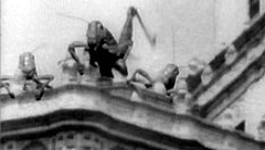
Despite
this tragedy, with the experiment a
success, the bomb drop is successfully
aborted in time. (And
the sharp eye will spot Kirk Alyn, the
original Superman,
piloting the plane.) By
now, though, the locusts are so spread out
over the city they must first lure them to
Wainwright's lab, and then into the
lake. Remaining at the lab, once Hanson
takes up position with more sound
equipment out on the water, Wainwright
tells Aimes to flip the switch. And as the signal
is broadcasted all over the city, weíre then
treated to several scenic postcards of
Chicago being overrun by the locust swarm. Drawn
along by the fake mating call, closer and
closer they come, and things start to get
a little hairy when a picture of the lab
is about to be swarmed under before the
signal is switched to Hanson's boat. Then,
in the grips of a sexually-charged
hysteria, the locusts plow into the lake
and dry-hump each other until they all
drown -- much to Hansonís delight.
The
End
Over
the years, I've always enjoyed Bert I.
Gordon's films and eventually came to
simply appreciate them for what they were
and for what they were not. What they have
is an old, pulp-novel noir thing
going for them. No frills, acceptable
special-effects for the era they were
made, and a straight
forward story barreling toward the climax
-- with
Albert Glasserís John Phillip Sousa-inspired riffs blaring and making our ears bleed
the whole way! What they don't have is a
lot of padding, nonsensical stock-footage
abuse, or the usual bait-n-switch involved
with these types of films, meaning you
usually got what you paid to see.
I
understand that while making Beginning
of the End,
Gordon had to use some really big
grasshoppers from Texas since the little
local ones couldnít hold the camera's
focus very well. However, to prevent an
ecological disaster, the California
Department of Agriculture wouldnít allow
this unless he could guarantee that all the
imported bugs were males. He complied, and I ponder
with pity the poor key grip who had to
turn each one over and make them pull
there pants down. And if you notice as the
film progresses, there are fewer and fewer
locusts left in the once mighty swarm.
Why? Well, according to
Gordon in Mark Thomas McGee's book, Fast
and Furious: The Story of AIP,
they had about 200 of the insects to start
with, but they weren't fed or stored
properly, and eventually turned
cannibalistic, so he barely had a dozen
left to finish the film. Luckily for us --
but not the grasshoppers,
apparently, he made it.
And
though I believe it originated with Stephen King in his
book Danse
Macabre,
I honestly can't remember exactly where the
rumor/legend started that you can see one
of the surviving grasshoppers defy gravity by
running off into nothingness as it crawls
up the photo of a building during the
final assault, but after swinging through
the climax over a dozen times I've yet to
find the errant culprit, which, speaking
frankly, is a bit of disappointment. A
couple on the fringes came close, but I
think that can be blamed on improper
formatting and cropping on all those old
VHS releases. And if you really want to
see the film as intended, be sure to check
out Image Entertainment's special-edition
DVD that shows the film properly matted in
its original 1.66:1 format.
Beginning
of the End
was the first of three films Bert I. Gordon
produced and directed, and wrote, and edited,
and lit, and special-effected, in 1957, and the
last, The
Amazing Colossal Man,
began his tumultuous but profitable
relationship with American International
Pictures that cemented his reputation as
Mr. BIG. Three pictures later, Gordon
brought suit against the company for
skimming profits, a rift that would last
until the mid-70's, when he would make a
brief but triumphant return with Food
of the Gods
and Empire
of the Ants.
In between, he had a moderately successful
run for both Allied and United Artists,
the pinnacle of which was probably The
Magic Sword
-- that really makes you wonder what he
could have done with a real Hollywood
budget. And when it's all said and done, I
think Gary Westfahl, in
The
Biographical Encyclopedia of Science
Fiction,
summed
up Gordon's career the best:
__
__ __ __ __
__ __ __ __
__ __ __ __
__ __ __ __
__
While
his early films were usually
threadbare -- classic mom-and-pop
operations, with Gordon and wife Flora
chipping in for most of the off-screen
labors -- they were not slapdash; within
the confines of his circumstances,
Gordon usually tried to do good work,
and if blessed with capable performers
and a decent story, he might succeed.
__
__ __ __ __
__ __ __ __
__ __ __ __
__ __ __ __
__
And
succeed he did, more often than not.
|